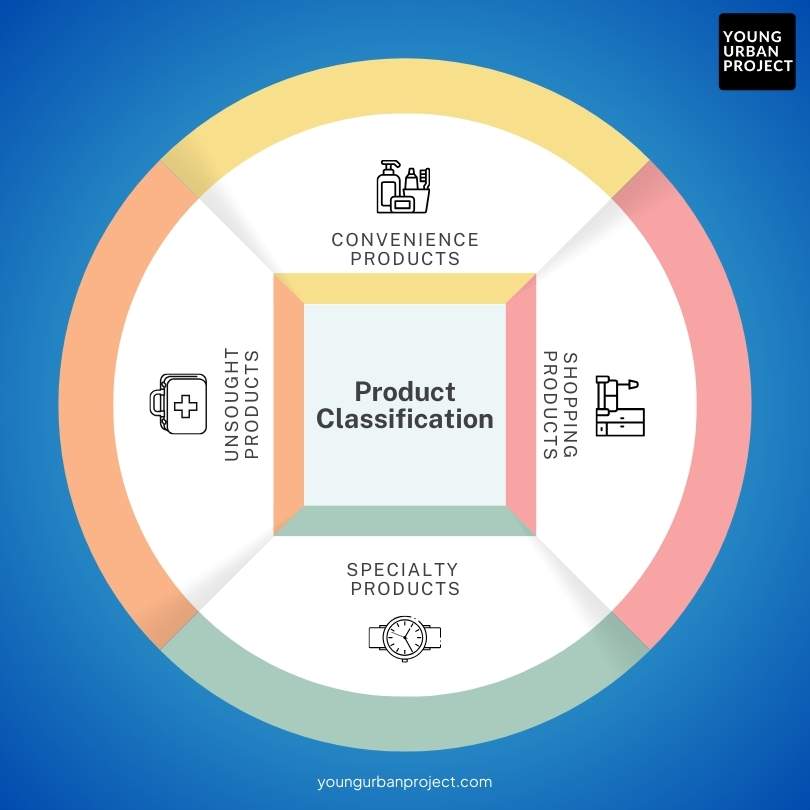Product classification in marketing categorizes products based on how and why consumers purchase them. For example you want to buy a shirt, a shopping good, for an interview. You will compare it with other shirts before buying and take your time deciding. But on the other hand if you are going to buy detergent, a convenience good, you won’t think twice and get the one you usually get.
This is how products are classified.
Everyone knows that a product is something of value that an organization offers to the market to fulfil a customer’s want or need. But do you know how important it is to classify these products as it’s crucial for marketing strategy and plays a key role in shaping the approach to sales, distribution, and promotion.
So, how are they classified? Let’s answer this for you in the blog.
Table of Contents
What Is Product Classification In Marketing?
Product classification is a foundational concept in marketing that categorizes products based on specific characteristics, consumer behavior, and usage patterns. By segmenting products into different classes, businesses can tailor their marketing strategies to better meet consumer needs, optimize their sales efforts, and enhance overall market effectiveness. This comprehensive approach ensures that marketing efforts are aligned with the unique attributes and consumer perceptions associated with each type of product.
Basis of Classification
Products are classified based on several factors, including:
- Consumer Behavior: How often the product is purchased and the level of effort involved in the buying decision.
- Price Sensitivity: The cost of the product and how it impacts the purchasing decision.
- Product Usage: The role the product plays in the consumer’s life and its frequency of use.
Types of Products

Convenience Products
Convenience products are items that consumers purchase frequently with minimal effort and consideration. These products are essential for everyday life and are typically low-cost and widely available.
Characteristics:
- High Purchase Frequency: Consumers buy these products often, often out of habit.
- Low Price: They are generally inexpensive, which encourages frequent purchases.
- Minimal Effort: The buying process is quick and straightforward, with little need for comparison or research.
Examples: Everyday essentials such as snacks, beverages, toiletries, and cleaning supplies fall into this category.
Marketing Strategy: To effectively market convenience products, businesses should focus on maximizing product availability and visibility. Placement in high-traffic areas, frequent promotions, and consistent branding can drive sales. The goal is to make the product as accessible and top-of-mind as possible.
Shopping Products
Shopping products are items that consumers purchase less frequently and usually with more consideration. These products often involve a comparison of features, quality, and price before making a decision.
Characteristics:
- Moderate to High Purchase Frequency: Consumers buy these products occasionally, often after careful thought.
- Higher Price: These products are generally more expensive than convenience items.
- Comparison and Research: Consumers invest time in researching and comparing options before purchasing.
Examples: Electronics, clothing, furniture, and appliances are common shopping products.
Marketing Strategy: Effective marketing for shopping products involves highlighting unique features, benefits, and competitive advantages. Detailed product information, comparison tools, and customer reviews can influence purchasing decisions. Providing a seamless buying experience and excellent customer service is also crucial.

Specialty Products
Specialty products are high-end, unique items that have a distinct appeal to specific consumer segments. Consumers seeking these products are often brand-loyal and willing to go to great lengths to obtain them.
Characteristics:
- Low Purchase Frequency: These products are bought infrequently but with significant intent.
- Premium Price: Specialty products command a higher price due to their exclusivity and perceived value.
- Strong Brand Loyalty: Consumers are typically very loyal to specific brands and may actively seek out these products.
Examples: Luxury items such as high-end watches, designer handbags, and exclusive cars.
Marketing Strategy: For specialty products, the focus should be on building a strong brand image and creating a sense of exclusivity. High-quality advertising, influencer partnerships, and limited-edition releases can enhance appeal. Providing exceptional customer service and personalized experiences helps reinforce the product’s prestige.
Unsought Products
Unsought products are items that consumers do not regularly think about or plan to purchase until a specific need arises. These products are often associated with emergencies or situations that require immediate attention.
Characteristics:
- Varied Purchase Frequency: Purchased only when a specific need or emergency arises.
- Variable Pricing: Prices can vary widely depending on the product and urgency.
- Need-Driven: The decision to purchase is driven by necessity rather than desire.
Examples: Life insurance, emergency repair services, and first-aid supplies.
Marketing Strategy: Marketing unsought products involves increasing visibility and educating consumers about the product’s importance. Use targeted advertising, educational content, and strategic partnerships to raise awareness. Positioning the product as a must-have in times of need can drive adoption and usage.
Importance of Product Classification
Product classification plays a crucial role in shaping a business’s marketing approach and overall strategy. Understanding the different types of product classification provides several key benefits:
Precision Targeting
By categorizing products, businesses can tailor their marketing efforts to meet the specific needs of each target audience. For example, marketing strategies for convenience products focus on accessibility and frequent purchases, while strategies for specialty products emphasize exclusivity and brand loyalty. Precision targeting ensures that marketing messages resonate with the intended audience, leading to more effective campaigns and higher engagement.
Optimized Pricing
Product classification helps businesses set appropriate pricing strategies based on the product’s category. Convenience products are often priced competitively to encourage frequent purchases, while specialty products may command premium prices due to their exclusivity and unique features. Understanding the product category allows businesses to price their products in a way that aligns with consumer expectations and maximizes revenue.
Strategic Placement
Effective distribution is crucial for reaching consumers and driving sales. Product classification informs decisions about where and how to distribute products. For example, convenience products should be widely available in high-traffic locations, while specialty products may be distributed through select channels that cater to specific consumer segments. Strategic placement ensures that products are accessible to the target audience and enhances overall market reach.
Enhanced Product Development
Knowing the product classification helps businesses focus on key aspects of product development. For shopping products, this might involve adding features that differentiate the product from competitors, while for specialty products, it could mean emphasizing quality and craftsmanship. Understanding the product’s role in the market guides development efforts to align with consumer expectations and market demands.
Building Brand Loyalty
Product classification contributes to building strong brand loyalty by ensuring that marketing strategies are aligned with consumer needs and preferences. By delivering products that meet or exceed consumer expectations, businesses can foster positive relationships and encourage repeat purchases. Tailoring marketing efforts to the specific category helps create a consistent brand experience that resonates with customers and enhances loyalty.
Also Read: Product Marketing Career Roadmap
Conclusion
Product classification in marketing is crucial. It helps businesses understand and navigate the complexities of the market. By categorizing products into different types, companies can develop targeted strategies, optimize pricing, enhance distribution, and build strong brand loyalty. In the modern market, effective application of product classification requires leveraging digital channels, utilizing data analytics, personalizing customer experiences, and staying agile.
Mastering product classification not only improves marketing efficiency but also positions businesses for success by ensuring that products are effectively aligned with consumer needs and market demands. Whether dealing with convenience items, specialty products, or unsought goods, understanding and applying product classification is key to unlocking marketing potential and achieving business goals.
FAQs: Product Classification
What is product classification in marketing?
Product classification in marketing involves categorizing products into different types based on characteristics such as purchase frequency, consumer involvement, price, and usage. This helps businesses tailor their marketing strategies, pricing, distribution, and promotional tactics to effectively meet consumer needs and drive sales.
Why is product classification important for businesses?
Product classification is important because it helps businesses develop targeted marketing strategies, optimize pricing, improve distribution, and enhance customer engagement. By understanding the different product types, companies can align their marketing efforts with consumer behaviors and preferences, leading to more effective campaigns and higher sales.
What are convenience products?
Convenience products are items that consumers purchase frequently with minimal effort and thought. They are typically low-cost and widely available, such as snacks, beverages, and personal care items. Marketing strategies for these products focus on accessibility and frequent visibility.
How do shopping products differ from convenience products?
Shopping products differ from convenience products in that they are purchased less frequently and involve more consumer research and comparison. They are usually of moderate to high price and require consumers to invest time in evaluating options, such as electronics, clothing, and furniture.
What defines specialty products?
Specialty products are high-end, unique items with distinct appeal to specific consumer segments. Consumers seeking these products often exhibit strong brand loyalty and are willing to make extra effort to obtain them. Examples include luxury cars, designer apparel, and high-end electronics.
What are unsought products and how are they marketed?
Unsought products are items that consumers do not regularly think about or plan to purchase until a specific need arises, often in emergencies. Examples include life insurance and emergency medical supplies. Marketing for unsought products involves increasing visibility and educating consumers about their importance, often through targeted advertising and strategic partnerships.
How does product classification impact pricing strategies?
Product classification impacts pricing strategies by guiding how businesses price their products based on their category. For instance, convenience products are often priced competitively to encourage frequent purchases, while specialty products may command premium prices due to their exclusivity and unique features.
How can product classification guide distribution decisions?
Product classification helps businesses determine the most effective distribution channels for each product type. For example, convenience products should be widely distributed in high-traffic areas, while specialty products might be sold through select, exclusive channels that cater to specific consumer segments.
In what ways can data analytics improve product classification?
Data analytics can enhance product classification by providing insights into consumer behavior, purchasing patterns, and market trends. This information helps businesses refine their product categories, develop targeted marketing strategies, and make informed decisions about pricing and distribution.
How can businesses adapt product classification strategies in the digital age?
In the digital age, businesses can adapt product classification strategies by leveraging online platforms and digital marketing tools. This includes using e-commerce to increase visibility for convenience products, utilizing detailed product listings and reviews for shopping products, and creating exclusive online experiences for specialty products. Data analytics and personalized marketing efforts also play a key role in adapting strategies to modern consumer behaviors.

